The Power of an Empowering Team
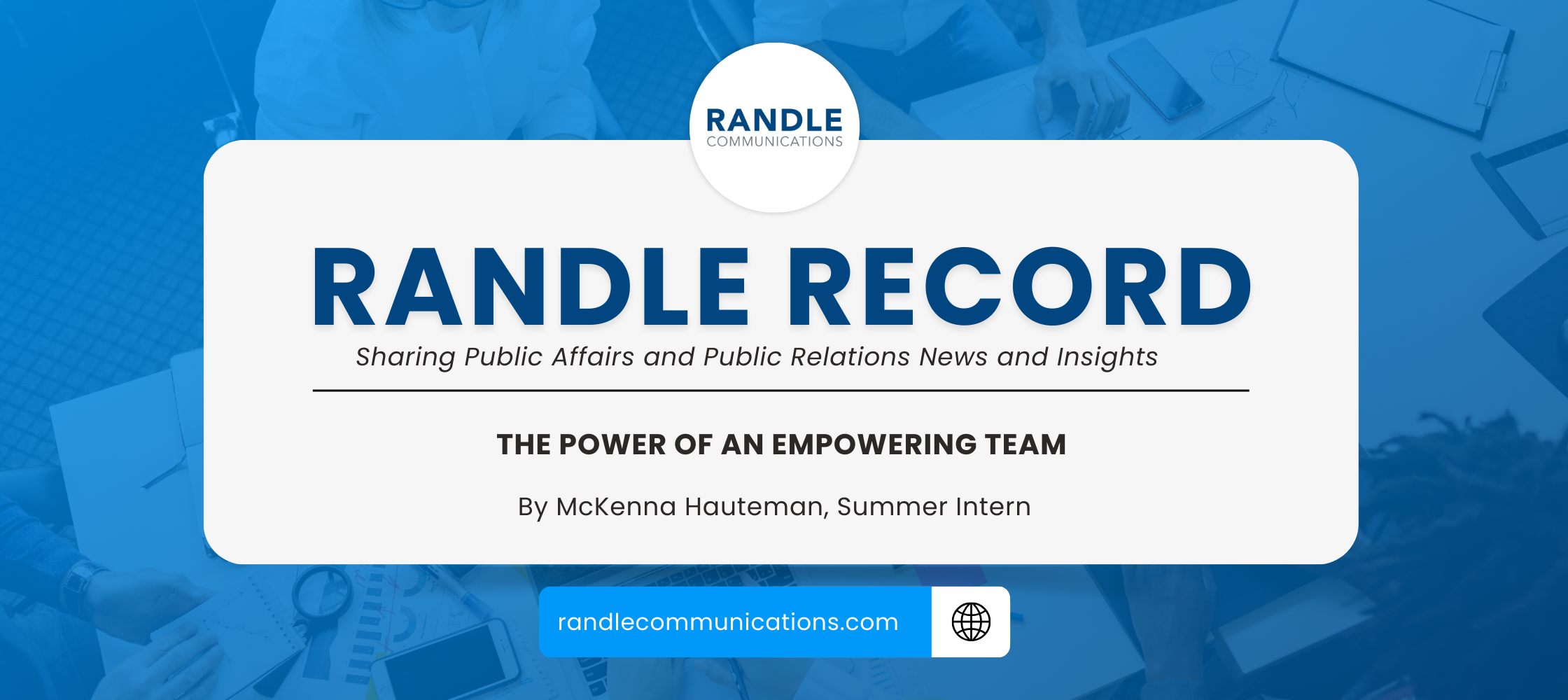
By McKenna Hauteman, Summer Intern at Randle Communications
When I started my internship at Randle Communications this past June, I could not have imagined the invaluable wealth of knowledge that I would gain about public relations and public affairs from the Randle team. If someone had told me three months ago that I would be crafting social media campaigns, facilitating advocacy efforts, drafting press releases, and helping to curate digital strategies across multiple platforms, I wouldn’t have believed them. This is mainly in part to my (now debunked) belief that my young age would be a limit to my ability to contribute to the exceptional team at Randle. Now, as my internship comes to a close, I have a renewed belief in my capabilities and a completely redeveloped vision for my personal and career goals in the future, all thanks to the incredibly empowering and encouraging team I had the privilege of working with as a 2023 Summer Intern.
Lessons Learned and Lived
It wouldn’t be hyperbole to say that I learned something new every single day of my internship. My account leaders’ and colleagues’ generous leadership approaches meant that they were willing to answer all my questions and walk me through any process I was unfamiliar with. Their patience and guidance allowed me to refine my skills while also broadening my understanding and perspective on the very wide and diverse set of work I was able to gain experience in. Being able to ask any question or receive extra support allowed me to build confidence in my skill set and courage to advocate for myself in the workplace.
Not only was I able to expand my conceptual understanding of public relations and public affairs during my internship, I was able to live these lessons out in hands-on experiential opportunities throughout my internship. Being able to speak face-to-face with clients, work on real, meaningful campaigns and contribute to developing strategies that would outlive my time as an intern was absolutely essential to my development as a young professional. The type of on-the-job experience I have gained as an intern has been the highlight of my internship overall, as this experience catalyzed my growth in a unique and special way.
Extracurricular Exploration
One of the defining characteristics of my internship was my ability to advocate for what I wanted to learn and gain experience in during my time with the team. Asking questions about my colleague’s experiences and respective roles at the firm helped me narrow down the areas of public relations and public affairs that I want to explore further as future career options.
Randle’s one-of-a-kind digital practice captivated my attention, as I found myself wanting to learn as much as I could about the profound effectiveness of a robust digital practice. I now have a newfound curiosity for all things digital, and being a part of the Randle team has allowed me to further explore this new interest. I was given the opportunity to take part in curating digital campaigns specific to client goals, to learn about the many facets of our digital practice and gain hands-on experience working to expand our clients’ online presence. I now leave with a renewed confidence in my capabilities and a vision for continued refinement of my skills.
The Difference an Empowering Team Makes
As I look back over the past three months, I am filled with gratitude for the team and their continued investment in my growth as a young professional. Randle Communications is set apart by its incredibly dedicated and passionate team, each of whom has taught me a different lesson on what it means to be in the public relations industry. As an intern, I was empowered to grow into my full potential and consistently encouraged to pursue my interests along the way. When I inevitably made a mistake, as all humans do, I was met with compassion and grace, turning a minor inconvenience into a valuable lesson. The support I have received from the team has been incredibly impactful for me as I continue to grow in my professional journey.
To anyone considering whether a Randle Internship is right for them, I say: Go for it! This experience has been beyond valuable to me, and as I continue to pursue my professional goals, I will never forget the lessons I’ve learned here in Sacramento as a 2023 Summer Intern.
Threads: What is it and the Sacramento Decision Makers and Political Influencers Using it
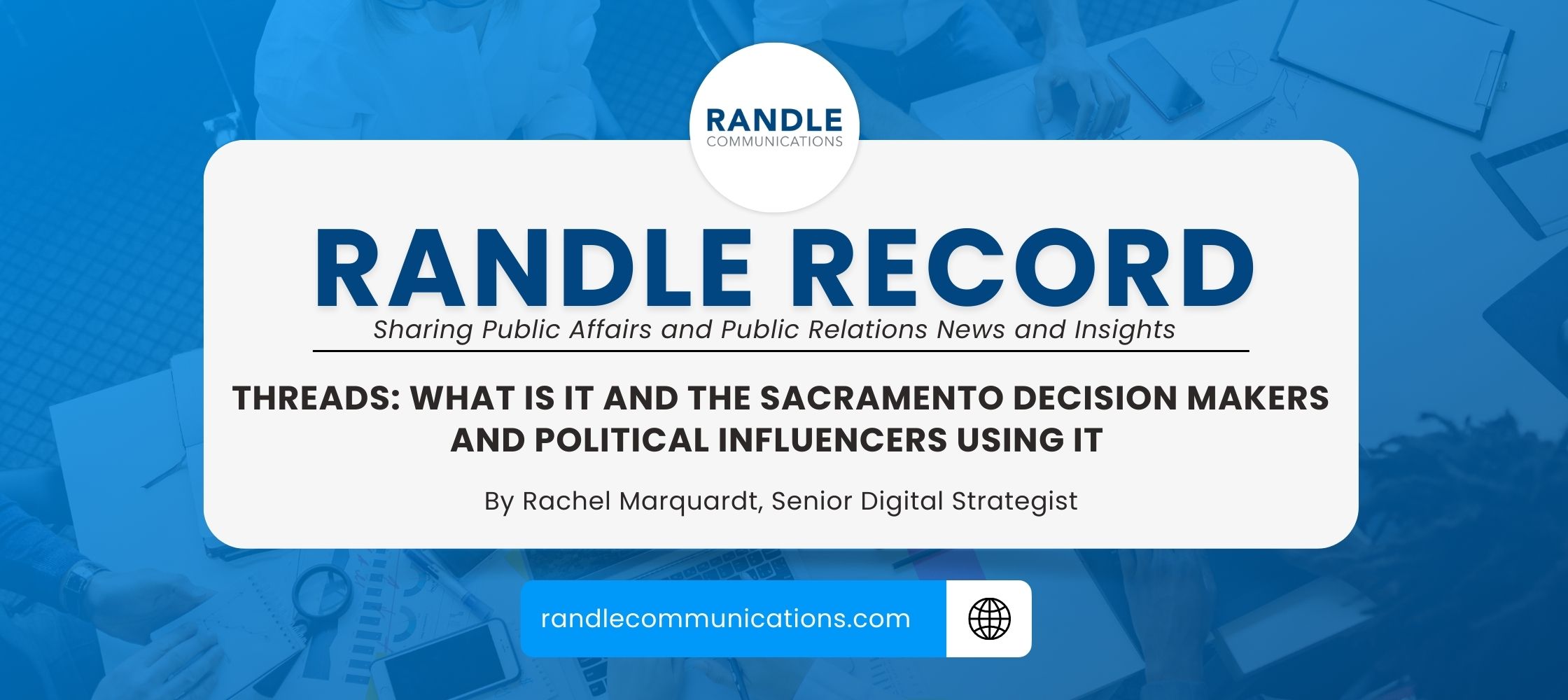
By Rachel Marquardt, Senior Digital Strategist
Since Elon Musks’ takeover and transformation of Twitter, the social media world has anticipated a new rival app. Now Twitter may have met its match with the arrival of Meta’s new app “Threads.” Since its release on July 5, the app has already set itself apart from other self-proclaimed Twitter-rival apps, with over 30 million sign ups and 1 million posts within less than 24 hours. According to Meta CEO Mark Zuckerberg, Threads now has 100 million sign-ups.
While it may feel like everyone is hopping on the platform, the app —nicknamed the “Twitter Killer” — is not without controversy, especially among legislators and key political influencers in Sacramento. And while its users continue to climb and the app’s capabilities improve, it’s still too early to tell if this young app will take over the Twittersphere and take the place as the go-to platform for Sacramento Beltway policy and political discourse.
Meet Threads — Instagram’s new sibling and Twitter rival
The development of the Threads app began six months ago when Facebook and Instagram creator-company “Meta” saw an opportunity to enter the race to create a “new Twitter.” Compared to other Twitter rival apps such as BlueSky, Threads was already a rising star, backed by the deep pockets of its parent company, Meta.
The platform looks strikingly like Twitter with the style of its sister platform Instagram, and has many capabilities similar to Twitter, such as posting, liking, reposting and sharing. Threads is also an algorithmically driven timeline, which means a user’s timeline will be a blend of who they are following and users they’ve never encountered before.
One of the most notable aspects of this platform is that it is already connected to Meta social media app Instagram. Currently, users cannot join Threads without having an Instagram account, as new users join by logging in through their existing account. Verification badges also transfer over – a seamless and stark contrast to the chaos and cost of Elon’s Musk’s Twitter verification process.
Other major differences between the two platforms include a 500-character count compared to Twitter’s 250-character limit, and the capability to post 5-minute videos compared to Twitter’s 2 minute and 20 second threshold, offering users additional space to share their opinions and perspectives.
Will Twitter be replaced?
While Threads has the same root capabilities of Twitter, the question still stands if it will adopt the same atmosphere and presence as the Twittersphere. Thanks to Meta’s deep pockets, Threads developers have the time and resources to adjust and update the platform to user needs. However, many Twitter users are arguing that Twitter continues to be irreplaceable.
Overall, we are seeing many prominent users post on both Threads and Twitter, meaning there’s potential. But will this take the place of the #CALeg Community? In the few days after the app’s launch there was a slow start from Sacramento lawmakers, although significant numbers of political and policy minds as well as the capitol press corps have launched profiles.
KEY SACRAMENTO DECISION MAKERS AND POLITICAL INFLUENCERS ON THREADS
List updated as of July 17 at 11:30 a.m. PST
| California Senate: 11 members | |
| Representative | Username |
| Angelique Ashby | senatorashby |
| Catherine Blakespear | senatorblakespear |
| Anna Caballero | senatorcaballero |
| Susan Talamentes Eggman | sensusaneggman |
| Melissa Hurtado | mhurtadoca |
| Brian Jones | senbrianjones |
| Monique Limon | moniquelimonca |
| Dave Min | davemin_ca |
| Steve Padilla | senatorstevepadilla |
| Susan Rubio | sensusanrubio |
| Scott Wiener | scott_wiener |
| Important Authorties | |
| Account | Username |
| Office of the Governor | cagovernor |
| Gavin Newsom | gavinnewsom |
| Eleni Kounalakis | eleniforca |
| California Assembly: 23 members | |
| Representative | Username |
| Dawn Addis | addis4centralcoast |
| Issac Bryan | ib2_real |
| Lisa Calderon | asmlisacalderon |
| Juan Carrillo | asmjuancarrillo |
| Wendy Carillo | wendycarrillo |
| Sabrina Cervantes | asmcervantes |
| Vince Fong | vincefong661 |
| Matt Haney | matthaneysf |
| Chris Holden | holden4supervisor |
| Josh Hoover | joshua_hoover |
| Jacqui Irwin | asm_irwin |
| Alex Lee | alex_lee |
| Josh Lowenthal | joshlowenthal |
| Devon Mathis | devon_mathis |
| Tina McKinnor | asmtinamckinnor |
| Blanca Pacheco | asmblancapacheco |
| Joe Patterson | patterdude |
| Eloise Gomez Reyes | egreyesca |
| Luz Rivas | luzmrivas |
| Robert Rivas | caspeakerrivas |
| Miguel Santiago | santiagoad54 |
| Buffy Wicks | asmbuffywicks |
| Lori Wilson | loridwilson |
| U.S. House of Represenatives from CA: 25 members | |
| Representative | Username |
| Jared Huffman | rephuffman |
| Mike Thompson | repmikethompson |
| John Garamendi | repgaramendi |
| Josh Harder | repjoshharder |
| Nancy Pelosi | speakerpelosi |
| Barbara Lee | repbarbaralee |
| Eric Swalwell | ericswalwell |
| Ro Khanna | rokhannausa |
| Kevin McCarthy | speakermccarthy |
| Jim Costa | repjimcosta |
| Tony Cardenas | repcardenas |
| Adam Schiff | adamschiffca |
| Brad Sherman | congressmansherman |
| Jimmy Gomez | repjimmygomez |
| Norma Torres | repnormatorres |
| Ted Lieu | reptedlieu |
| Sydney Kamlagar | rep_kamlagerdove |
| Linda Sanchez | replindasanchez |
| Robert Garcia | robertgarcialb |
| Nanette Barragan | repbarragan |
| Lou Correa | reploucorrea |
| Katie Porter | repkatieporter |
| Mike Levin | repmikelevin |
| Scott Peters | repscottpeters |
| Sara Jacobs | repsarajacobs |
| U.S. Senate Representatives: None | |
| Media Reporters | |
| Name | Username |
| Ashley Zavala | zavalaa |
| Lara Korte | bylarakorte |
| Morgan Rynor | morganrynortv |
| Eytan Wallace | eytanwallace |
| Melanie Mason | melmason |
| Elex Michaelson | elexmichealson |
| Carla Marinucci | carlamarinucci |
| John Myers | johnmyers_ |
| Liam Dillon | lidillon |
| Christopher Cadelago | ccadelago |
| Melanie Mason | melmason |
| Media Outlets | |
| Outlet | Username |
| Capitol Weekly | capitolweekly |
| San Francisco Chronicle | sfchronicle |
| Sacramento Bee | sacramentobee |
| Cal Matters | calmatters |
| Los Angeles Times | latimes |
| Business Wire | businesswire |
What’s next for the political and communications world?
While it’s too early to say if Threads will live up to its “Twitter Killer” nickname, it appears to be its fiercest competitor yet, with its user base rising quickly. What also remains to be seen if it can take the place of Twitter, which is the platform for political and policy discourse. In addition, Meta’s goal is to have Threads work across multiple apps to create what is called the Fediverse — a federated universe of services that all work under the same.
Updates ahead
While the app is flourishing with users, its capabilities are bare bones. This means updates and changes are likely to happen quickly and frequently as the platform grows. Many users already have expressed interest in the platform adding a direct messaging capability and the ability to create lists as Twitter does, those features have not been activated but we can expect it will be soon. Other significant additions mentioned by Adam Mosseri, Head of Instagram, as “on his list” include…
- A website interface. Currently Threads is an app only.
- A “trending” feed, similar to Twitter’s current trending feed.
- An elevated search that includes the ability to search topics and hashtags
- A feed that includes only people you follow.
- An option that allows only people you know to reply to your thread.
A way to advertise through Threads is also on the list, but Mosseri has mentioned that opening ad capabilities on the platform is not a top priority just yet. According to Mosseri, the app team is prioritizing making the app efficient and ensuring users continue to grow before turning the focus to monetization.
So, how do you sign up for Threads?
If you, your team or the organization you represent has an Instagram account already, it is an easy process to sign up and explore the platform. Depending on preferences, the best strategy may be to begin posting on the platform. But keep in mind that even if you decide to go “full speed ahead” on Threads, it doesn’t mean Twitter or any other prominent social platforms are less relevant — yet. For organizations who do not have an Instagram account, now may be the time to consider creating one in order to save your username for a possible Threads account in the future.
The accelerated adoption of the new platform Threads is an exciting prospect, and we are waiting in anticipation to see if the app takes a seat at the table of important social platforms like Instagram — and steals Twitter’s seat after all. Only time will tell how it will impact the Sacramento echo chamber, our communities, and the way we communicate.
Twitter Verification Checkmark Required to Run Ads
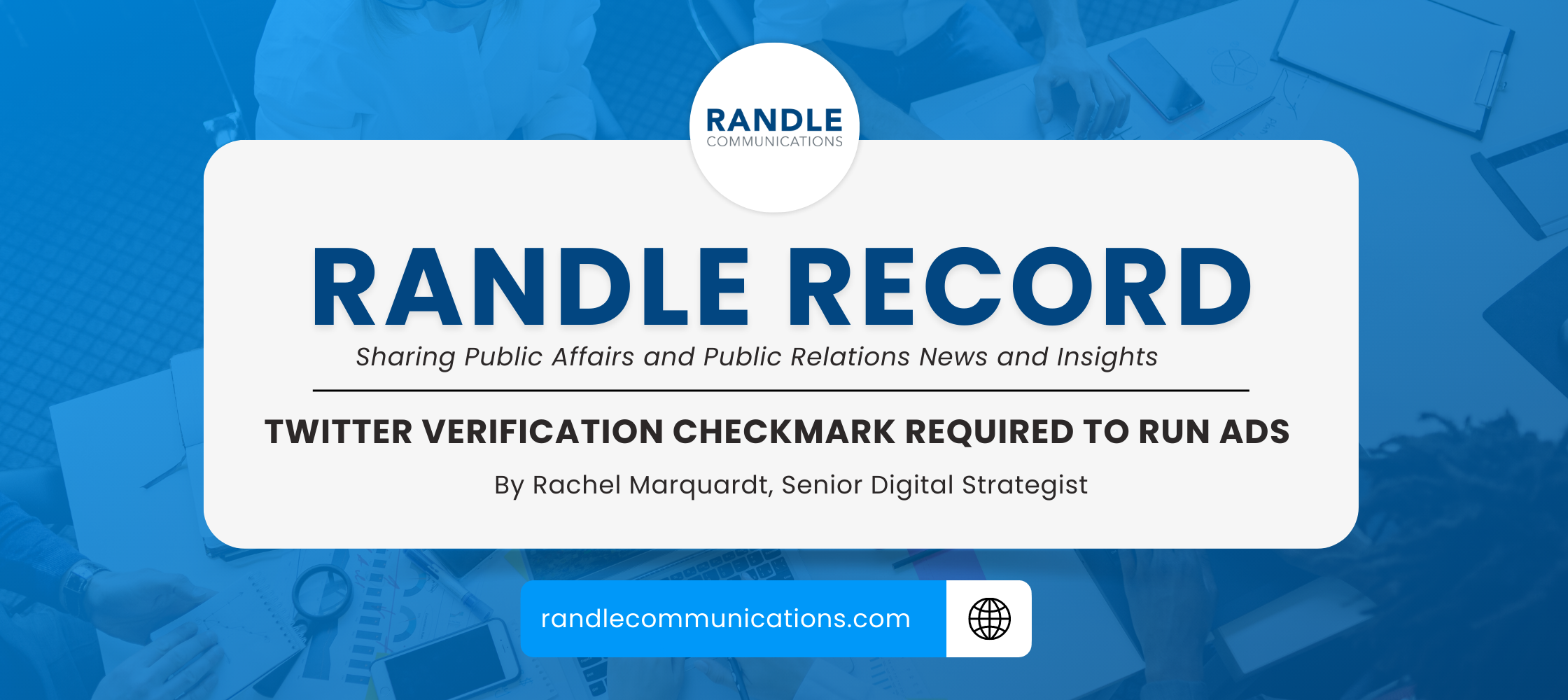
By Rachel Marquardt, Senior Digital Strategist, Randle Communications
It’s been a tumultuous several months for Twitter as extreme changes have continuously been implemented to the channel under its new ownership. Among all the buzz and announcements, one of the most impactful changes for advertisers lies in a thin drop-down banner notification in Twitter’s paid ads platform. This update informed Twitter Ads users that as of April 21, the app would begin withholding paid digital ad options for any organization not verified with a checkmark on Twitter. It also informs advertisers that if they have booked or book a future campaign of more than $1,000 with Twitter, the account will automatically be eligible for a complimentary gold checkmark – for now. The announcement followed a large purge of blue checkmarks from previously verified accounts on the platform just the day before.
At Randle Communications, Twitter serves as a key advertising tool that is often incorporated into our paid digital strategies and acts as an essential communication channel to support brands in a variety of industries to pinpoint key audiences and markets. Now, we are supporting our clients in a reassessment of their strategies to help them make a key decision: Whether or not to subscribe to Twitter and obtain a verification checkmark in order to advertise on the platform.
This requirement is part of Elon Musk’s long-term plan to monetize the platform and decrease bots. It has since created a significant barrier to entry across the platform for advertisers big and small. According to a notice from Twitter, the “change aligns with Twitter’s broader verification strategy: to elevate the quality of content on Twitter and enhance your experience as a user and advertiser. This approach also supports our ongoing efforts to reduce fraudulent accounts and bots.”
Now, organizations must decide to either adjust their digital paid ads strategy to not include Twitter advertising, or pay for one of the new Twitter verification subscriptions to receive a checkmark.
The Removal and Addition of Verification Checkmarks
Twitter has introduced three new checkmarks after its removal of the classic blue checks that the Twitterverse had become accustomed to:
- The first of Twitter’s new verification subscription levels is the familiar Twitter Blue, where users can pay for a blue checkmark and a few benefits for $8 a month. Benefits Twitter provides to Twitter Blue users include the ability to run ads as well as edit Tweets, bookmark folders, be prioritized in conversation rankings, ironically see fewer ads on their own feed, and a few additional content-based benefits.
- A gold checkmark comes with Twitter’s Verified Organizations program, which sits at $1,000 a month as a baseline. After being approved for the program, Verified Organizations will have all benefits of Twitter Blue, as well as the ability to add affiliate accounts to their Verified Organizations hub.
- Twitter’s third verification level is a gray checkmark. A variant of the Verified Organizations mark, the checkmark is a free symbol of verification for government-affiliated organizations and multilateral institutions.
To explore further benefits of each of the platforms, visit here.
This expanded version of Twitter’s paid verification system creates a pay-to-play model that may serve as a force for decision-making for many brands and organizations. The hesitancy to hop onto Twitter Blue still remains, but it is still to be seen whether brands will take their pick of the options above or take their leave.
In the aftermath of the announcement, we have seen both sides of the argument, with some elected officials refusing to pay for Twitter Blue after losing their checkmarks, while other organizations are “reluctantly” purchasing it. A Twitter verified checkmark already comes with a predisposed amount of uncertainty, due to the backlash from Twitter advertisers and users during their first iteration of Twitter Blue. This announcement transformed the blue checkmark into a threat, allowing anyone to purchase the symbol for a mere $8, no matter what their account represented. This created a storm of controversy, confusion, and consequences due to fake accounts and misrepresentation, resulting in many advertisers backing away from Twitter.
The Other Changes – And Rumors
These changes to verification statuses are accompanied by a plethora of other changes that align with Musk’s monetization plan, several of which experts believed would cause the downfall of the app itself. While many of these changes have been solely focused on placing costs on once-free content such as its Application Programming Interface (API) and verification checkmarks, Musk has also significantly adjusted Twitter’s original format to prioritize content creators, making room for long-form tweets, videos, and more visual content. These changes, we can assume, are aimed at appealing to younger generations (while creating more options and room for advertising, of course). This may be the reason that Twitter’s download and usage rates remain strong, even amongst the chaos that followed shortly after Elon Musk’s purchase of the platform when many experts predicted that it was heading for demise., making room for long-form tweets, videos, and more visual content. These changes, we can assume, are in hopes of appealing to younger generations (while creating more options and room for advertising, of course). This may be the reason that Twitter’s download and usage rates remain strong, even amongst the chaos that followed shortly after Elon Musk’s purchase of the platform when many experts predicted that it was heading for demise.
However, many believe that the largest reason Twitter remained above water was the absence of an alternate app the Twitterverse felt comfortable moving to. Now that may change with the new app “Bluesky,” created by former Twitter CEO Jack Dorsey. While the app has topped headlines as the possible resolution in the “Hunt for the Next Twitter,” currently it is invite-only where potential users must sign up for a waitlist. By the end of April, Bluesky had reached 50,000 users, including public figures such as Alexandra Ocasio-Cortez (D-NY) and organizations such as NPR – who recently and very publicly exited Twitter – finding a home on the platform.
What’s Next?
As we all know from experience, we can expect more changes from Twitter coming our way. Since the announcement, Twitter has already reinstated free blue checkmarks to accounts with over a million followers. This included LeBron James, who was “gifted” his blue checkmark back “on behalf of Elon Musk” after James refused to pay for Twitter Blue. Celebrities such as Stephen King and William Shatner received free checkmarks as well.
Twitter serves as an ongoing case study of the ever-evolving world of digital, and the importance of social media marketing. With this new significant barrier to entry for Twitter advertising and its attempt to force the Twitterverse to adopt these new paid verification options, many are flagging this as one of Twitter’s riskiest moves. As advertisers hold Twitter in their hands, we are sitting at the edge of our seats waiting to see if they will bend to the new requirements and purchase a checkmark or break away from Twitter as a paid marketing channel, which may spell concern for Twitter itself.
The only thing we can say for certain is that we are in anticipation of what changes are next with Twitter, and to see if it can withstand its biggest test yet.
Major Lessons From My Internship from a Soon-to-Be College Graduate
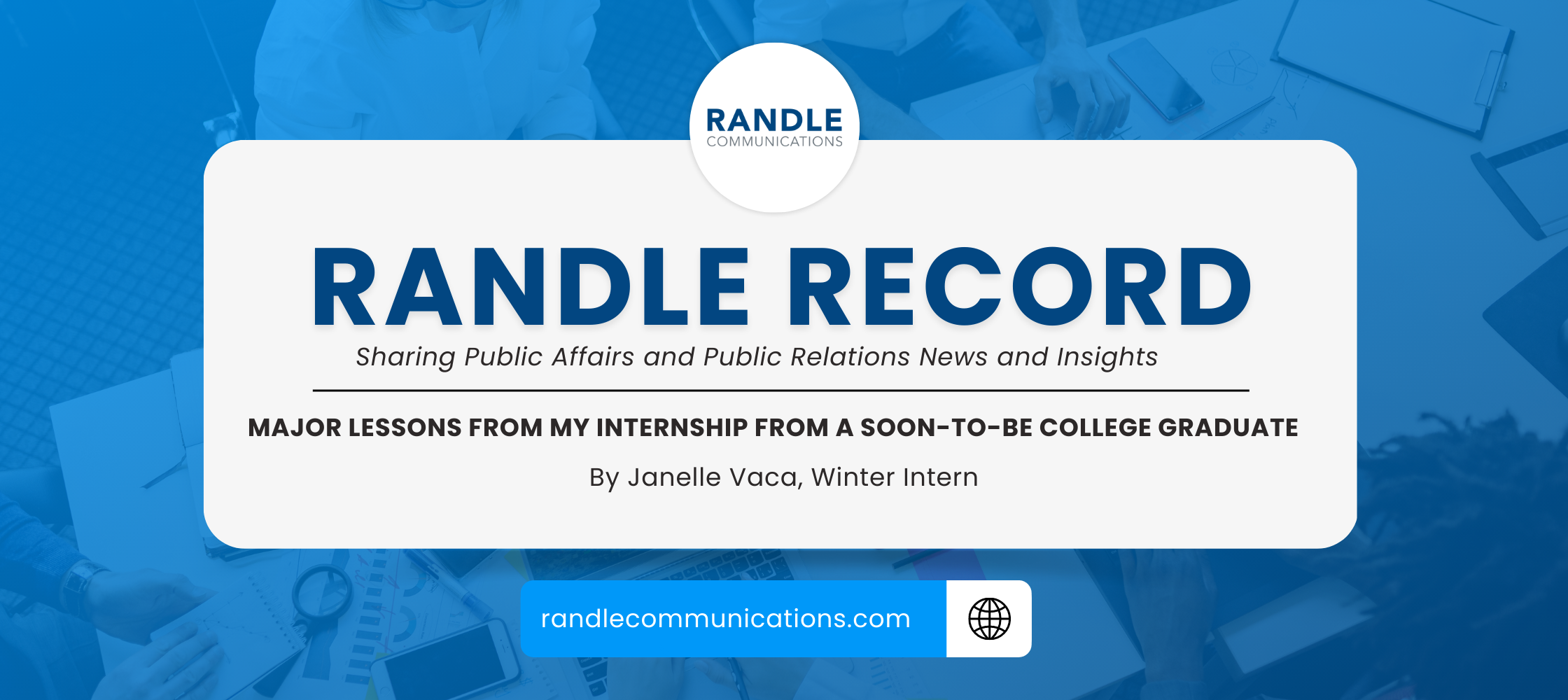
By Janelle Vaca, Winter Intern, Randle Communications
For the last three months, I had the opportunity to navigate the exciting and challenging world of public relations and public affairs as an intern at Randle Communications. As a soon-to-be communications graduate from Sacramento State, I believe the insights I gained from my internship positively shaped my understanding of the industry as well as my future career path.
From Pajamas to Professional: Balancing School and Work as an Intern
Navigating the landscape of the Sacramento communications world as an intern has been an adventure. As a full-time student, balancing the demands of school and work was a challenge, but I quickly adapted to the hybrid environment and learned to work effectively from home.
During my first day at Randle, I was met with a new industry lexicon of industry language and business acronyms including CTA, KPI, PAC, ROI and many, many more. But with the help of my colleagues and mentors, I studied and quickly picked up on the terminology. My colleagues were patient and happy to explain any concepts or acronyms that I didn’t understand.
My first piece of advice for interns is to always ask questions, especially if you are unclear of what something means. There are a lot of acronyms in PR, and it can be confusing at first, but asking for help from those who have been in the industry for many years is the best way to learn and grow in your role.
Lights, Camera, Impact: Behind the Scenes
One of the most exciting aspects of my internship was the opportunity to learn about the energy, effort and strategy of activities conducted behind the scenes. As a public relations/public affairs firm, much of our work to position clients, industries and issues happens behinds the scenes. I gained a new appreciation for the importance of this work and what it takes to support client partners and achieve their goals through strategic communications and advocacy. I was, as an example, extraordinarily proud to be a part of a team who supported the important work of a local health care organization. Together, we helped make a positive impact in the community, and I learned firsthand how vital PR/PA work is in shaping public discourse and educating key audiences. It was a great feeling to be a part of something bigger, and to see firsthand the positive impact that we had on the local community.
From Social Media Rookie to Messaging Master: Skills I Learned
During my time at Randle, I also developed a range of valuable skills that will be useful throughout my career. Not only did I observe the mastery of the firm’s senior digital strategist, but I also learned the importance of creating effective messages that match platform distribution and are generated from trusted ambassador voices.
I also practiced executing work while under tight deadlines, a valuable skill in any workplace, but a necessity in the fast-paced world of public relations and public affairs. Traditional and new media landscapes are full of evolving content and with issues rapidly and constantly changing, and I saw firsthand the importance of flexibility and time management to ensure tasks are completed on time. In an agency, things move quickly, and I learned to ask colleagues for specific timelines to help prioritize my tasks, and those timelines were frequently adjusted throughout the day. I’m grateful to my team for helping me learn more about prioritizing activities and perfecting the art of time management.
Carbs and Communication: The Importance of Building Relationships
Networking is key in public affairs and public relations to meet and connect with other professionals and industry players. I was fortunate that my internship included frequent mentorship sessions and daily engagement with members of the firm’s leadership team. We also enjoyed weekly all-team meetings to connect with other coworkers, usually over some morning bagels or other goodies. This streamlined my onboarding process and helped me feel more comfortable in the office right away. The regular networking events were always a highlight of my week because I loved having the opportunity to connect with professionals in my field and learn from their experiences. It’s essential to take what you learn about networking with you after your internship. As you continue to grow in your career, don’t be afraid to ask other professionals out for coffee or lunch, attend industry events, and stay connected with your former colleagues. The connections you make during your internship and beyond can be invaluable for your professional development and help you succeed in the field of public affairs and public relations.
Lessons Learned and Future Goals: Reflecting on my Internship
Looking back on my internship at Randle, I’m proud of everything I learned and grateful for the experiences I had. I’m especially thankful for this introduction to the professional world, which will help me further my future in communications. My team gave me a head start on how to use programs that I will use for the rest of my career. Thanks to Randle, I feel more prepared and confident than ever as I embark on my career in the communication field.
If you’re considering an internship in public relations or public affairs, I can’t recommend Randle highly enough. It’s a challenging and rewarding environment that will help you develop valuable skills and make a positive impact on the community.
Leveraging Social Media to Cultivate and Strengthen Coalitions
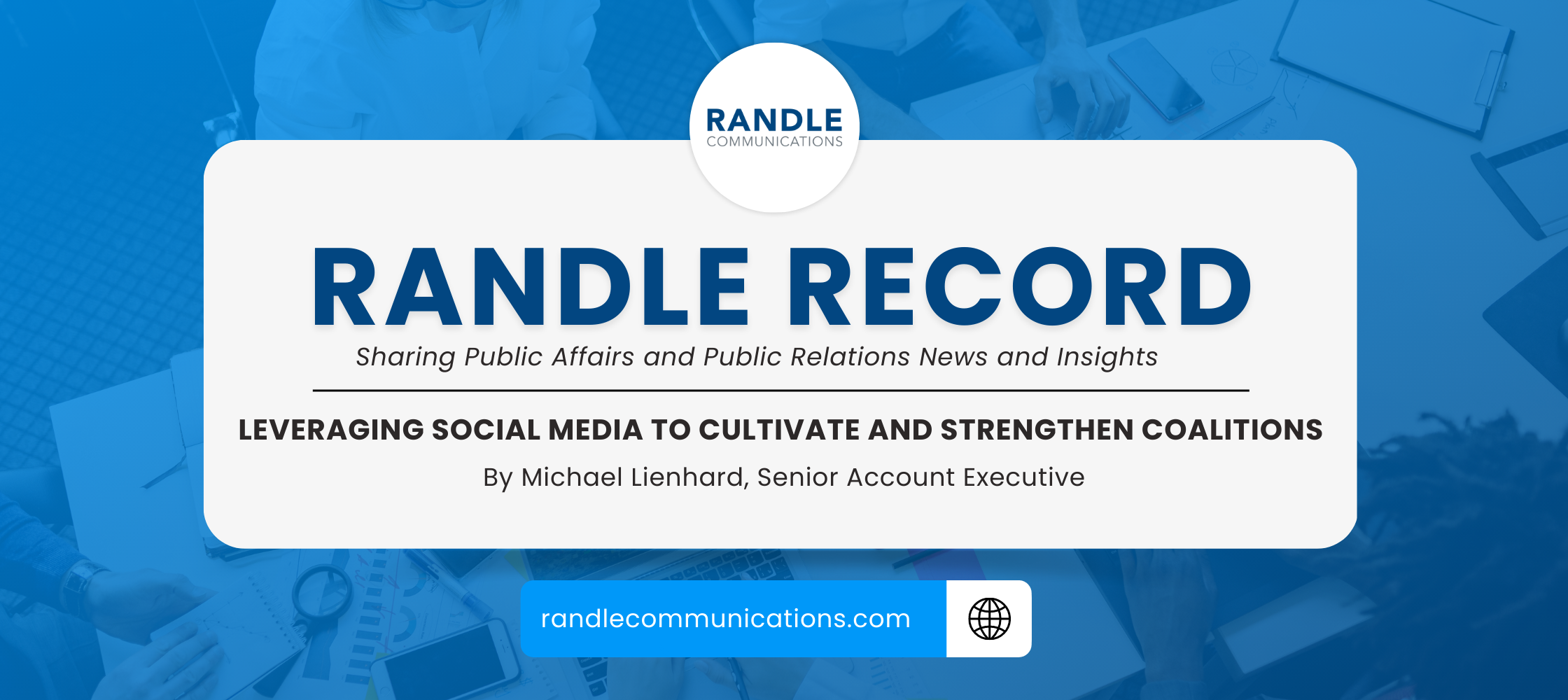 By: Michael Lienhard, Senior Account Executive, Randle Communications
By: Michael Lienhard, Senior Account Executive, Randle Communications
A critical public affairs strategy for success is building an authentic coalition of partners who champion your cause. Coalition building includes cultivating a group of stakeholders, often from diverse backgrounds, that have unique viewpoints but a shared stake in the outcome of policy decisions. While digital platforms and social media are ubiquitous in 2023, online platforms are often overlooked as a tool for creating and growing coalitions.
From recruiting potential partners to engaging with existing allies, social media can expand reach, mobilize supporters and amplify messages. Below, we examine the role of social media in coalition building and provide three best practices to leverage social media to build successful coalitions and win for our clients.
- Identify Prospective Coalition Members
Who are existing allies and how can we identify new partners? Consider the individuals, organizations and other influencers who share goals or have a stake in the issue at hand, even tangentially. Use social media listening tools, to analyze online conversations, to identify organizations, individuals and groups with shared views.
When examining potential partners consider individuals and organizations with large social media followings or other forms of influence, such as high engagement rates or loyal followers.
2. Leverage Social Media for Partner Engagement
Once potential partners have been identified, the next step is to engage by commenting on posts, sharing content, tagging individuals and organizations in posts or articles of common interest, and reaching out directly to share your goals and propose ways of collaboration. It’s important to be sincere with all interactions and to avoid simply asking for their support. Instead, focus on building genuine relationships and finding ways to collaborate on shared goals.
In addition to reaching out to potential partners, social media is a must when engaging with existing coalition members. This could include sharing updates on the campaign, highlighting the work of coalition members and providing engaging content and opportunities for members to share their own stories and experiences related to the issue. Keeping coalition members engaged and informed can help build a sense of community and momentum around the campaign.
3. Measure Success and Partnership Engagement
If you can’t measure impact it is difficult to determine effectiveness, so it’s important to track and analyze social media efforts and make refinements as necessary. Establishing goals at the onset and monitoring engagement metrics such as likes, comments and shares, is key to gauge the impact of efforts to grow the coalition over time. By analyzing this data, you can identify what’s working and what’s not, and adjust the social media strategy accordingly.
Social media is a powerful tool for building coalitions in strategic public affairs campaigns. By identifying potential partners, engaging with existing coalition members and leveraging influencers, campaigns can use social media to expand their reach, mobilize supporters, amplify resonance and ultimately deliver winning results. Randle Communications follows these best practices to help clients achieve their goals.
5 Ways to Increase Innovation at your Agency or Organization
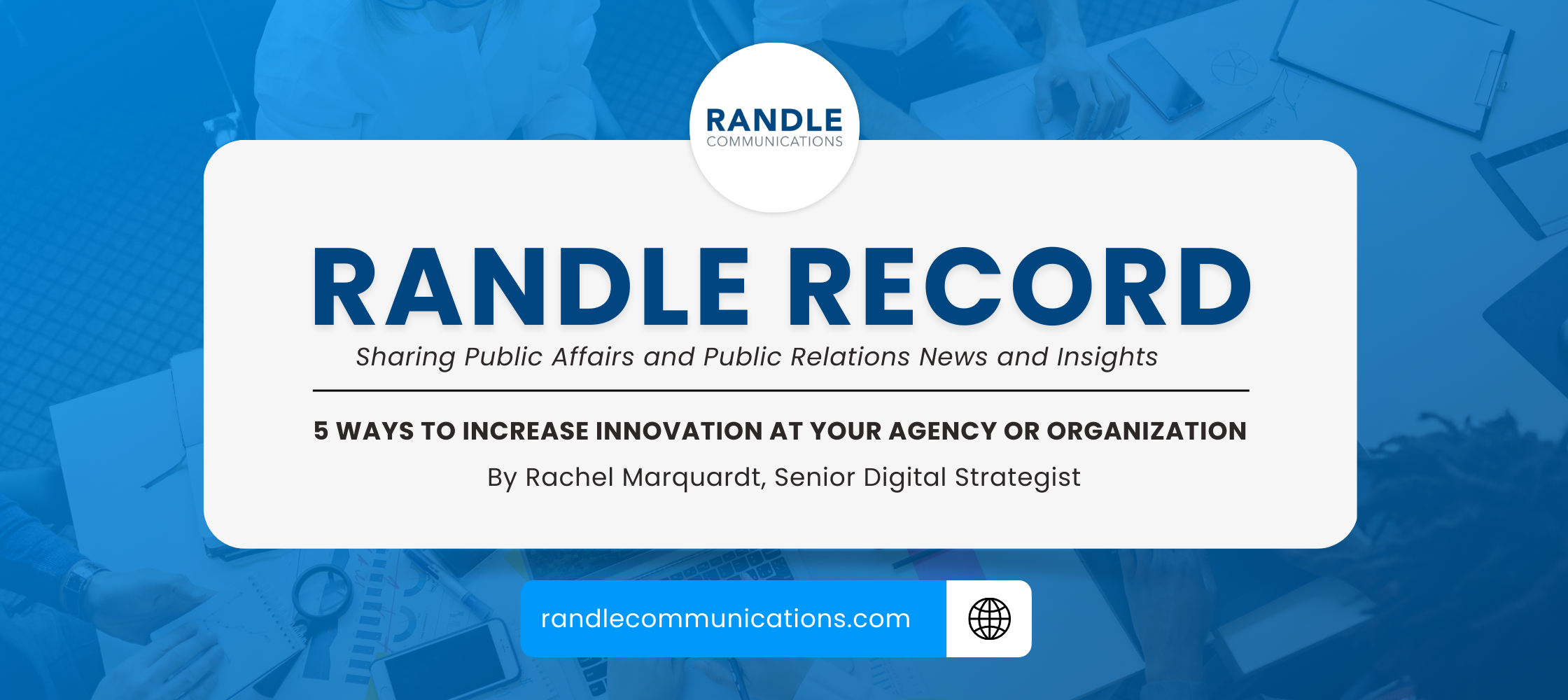
By Rachel Marquardt, Senior Digital Strategist, Randle Communications
The hustle and bustle of agency life includes full schedules, complex projects and client objectives, and professionals with diverse strengths and skill sets. The landscape doesn’t easily create space and time to pursue new ideas and breach the innovative frontier, but as the digital world continues evolving, it’s critical agencies ensure their teams are positioned to maximize new technology, ideate and problem-solve while still supporting their clients with industry-leading services.
Here are a few tips that could benefit your agency as you work to weave in time for innovation for your busy team.
1. Embrace Strategies to Turn Pressure into Productivity
Did you know that individuals are most creative at a specific time of day? It’s science – when the brain is overwhelmed, it leaves no room for creativity. This may give readers who are in the agency world the urge to stop reading this article altogether because it can be difficult to unclutter your mind when there is consistent pressure to provide the highest quality work for clients. The answer is this: Harness pressure into productivity.
When stress becomes overwhelming, something neurologists refer to as “downshifting,” a state of fight or flight occurs where your brain’s pathways are not open to creative ideas, only ideas that will support survival. However, there are ways to “upshift” your brain out of this state and into a state of creativity and productivity, according to Leading Crisis Management Expert Ben Ramalingam in his book “UpShift.”
There are a few things you can do to upshift your brain and turn pressure into productivity, including:
- Reset your mind by taking a quick walk or getting a breath of fresh air
- Work in a different space of the office than usual for a period of time (if in person)
- Meditate or practice deep breathing
- Use a grounding technique such as a stress ball, journal, or inspirational quote to take your brain away from a stressful task
- Let a digital or on-paper to-do list take ownership of keeping track of your day-to-day tasks, so your brain has more room for creativity
These disruptions to your standard flow or routine will give your brain the opportunity to upshift.
To learn more about upshifting, check out the book “Upshift” by Ben Ramalingam.
2. Optimize Your In-Person or Virtual Collaboration Time
Brainstorming – a concept initially invented by Alex Osborn in the 1950s – is best done together in an inclusive, undistracting environment. This means setting aside other tasks to focus on one goal, together, whether in a virtual setting or in person. Optimize your in-person or virtual collaboration time by scheduling 30 minutes to 1 hour for your team to brainstorm solutions to one challenge without any other agenda items or distractions. At Randle Communications, we value using our brainstorming space to set aside focused ideation sessions where we don’t let other client items or tasks interfere.
3. Encourage Diverse Perspectives to Generate Ideas
There is great value in incorporating diverse skills and perspectives into a team who is looking to problem-solve. Unlike what some may believe, it isn’t the similarities between team members that hold the most value but their differences. This means different backgrounds, departments, skills, and levels in your organization too. It takes multiple personalities, ideas, and perspectives to achieve goals and see innovative ideas through.
There are many helpful tools for helping people pinpoint their productive personalities and where they best fit when it comes to innovative problem-solving. For example, is there someone in your office who is an endless idea generator? Or how about someone who likes to take a plan and jump in to make things happen? These people are just some of the many puzzle pieces that fit to make an innovative team.
Many people believe it is an innate personality trait to be innovative or be a “problem-solver,” but that is truly not the case. This means when you’re assembling your project teams or bringing people together to solve a problem, even someone who may not feel like they have the “innovative” gene might have the perfect piece to finish your team’s puzzle. If you’re interested in learning how your team can harness their skills and personalities in the workplace, check out FourSight, or The Ten Faces of Innovation by Tom Peters.
4. Quantity Will Lead to Quality
You have the team, you’ve set aside the time. But how do you plan a productive brainstorming session? When it comes to brainstorming ideas that will lead to innovative solutions, quantity will lead to quality. This concept was coined by Osborn and has been researched and confirmed by multiple creativity, innovation, and behavior researchers.
In order to develop quality concepts from a quantity of ideas, here’s a quick sequence to try in your brainstorming sessions:
- Define your challenge, or the problem you are hoping to solve.
- Have your team individually write down as many ideas as possible.
- Have each team member add their ideas to a whiteboard, or a virtual list for the team to see.
- Begin discussing which of the ideas are most viable. Can multiple ideas connect? Do some of the ideas spark others?
- From there, pick the idea or ideas the team wants to move forward with, and begin making a plan to address your problem.
Practice omitting the word “no,” from these brainstorming sessions, as someone’s “no” might be a YES from a differing perspective, or could pair well with another idea.
5. Create an Innovative Space… Physically.
This last section is for teams with a hybrid working schedule or mainly work in-office. If your space is drowning in division due to a large number of physical dividers, consider reimagining a part of your office space for your team. Prioritize building a common space for brainstorming and creativity. Here are a few suggestions for building out your collaboration space:
- Incorporate a White Board: This will help increase collaboration by allowing the team time away from screens and with each other.
- Make it a Comfortable Space: Swap out the swivel chairs for couches and make sure there’s enough for the group, big or small.
- Place it in a Prominent Location: If your workspace allows it, select a location that is easily accessible and people pass by frequently.
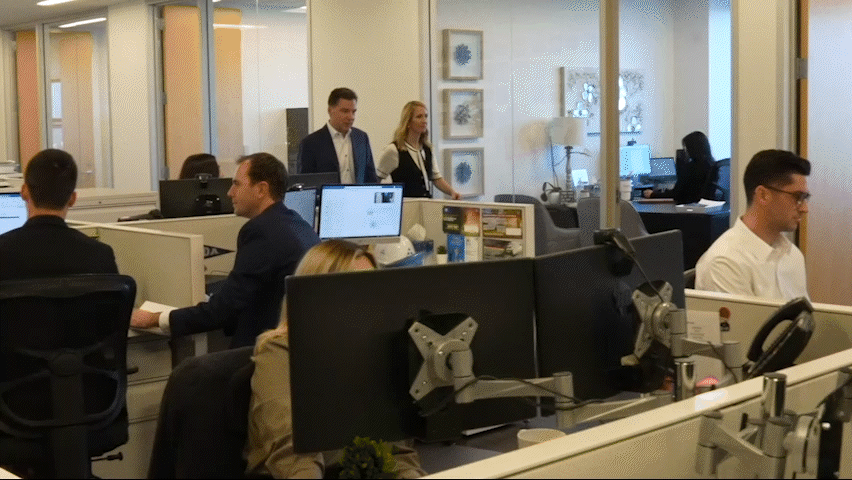
First-of-its-Kind Legislative Staff Survey Finds California’s Capitol Can’t Function Without Digital Advocacy
SACRAMENTO, Calif. – Sacramento’s top public relations and public affairs firm, and digital advocacy pioneers, Randle Communications (Randle), today released its fourth annual Digital Influencer Report, which details how social media is used to advance policy in California’s legislative process. The report includes findings from a first-of-its-kind survey of legislative staff on the effectiveness of digital advocacy and highlights the most powerful digital strategies and tactics in a legislative environment defined by the lasting impacts of COVID-19.
“COVID-19 turbocharged the already rapid shift to digital advocacy in California’s Capitol,” Jeff Randle, President and CEO of Randle Communications said. “Our survey of legislative staff found that digital advocacy is more important than ever before and essential to moving the needle with lawmakers.”
The survey found that more than three-quarters of legislative staff survey respondents (76.9%) say digital advocacy is more important to advancing policy due to COVID-19 impacts. Here’s what legislative staffers are saying:
- “Digital advocacy has been one of the only ways for advocates, organizations, and legislators to spread the word on a bill.”
- “When people advocate for an issue on social media, it is just like them making a phone call to our office or an in-person visit. We read what they are saying, who is saying it, how frequently they are saying it.”
- “Now we pay more attention to digital advocacy but still give proper consideration to other forms of communications.”
Given these insights, our report outlines three important lessons:
- COVID-19 accelerated the new era of digital-first advocacy
- Virtual advocacy is here to stay
- Authentic content – and voices – are essential to digital success
Click here to read the 2020 Digital Influencer Report and access the survey findings.
“What we heard from legislative staff is simple: California’s Capitol can’t function without digital advocacy,” Lindsey Goodwin, Vice President of Public Affairs at Randle Communications said. “Those who win in the post-COVID-19 world prioritize an engaging content strategy that elevates authentic voices and recognizes that virtual advocacy is here to stay.”
Randle designs custom public affairs programs with strategic digital elements to help clients achieve their advocacy goals. Randle’s in-house creative and content team, the Randle Content Studio, includes proprietary News-Style Impact Videos, authentic social content development and a comprehensive toolkit of traditional media as well as paid digital strategies.
About Randle Communications:
Jeff Randle created Randle Communications in 2001 with partner Mitch Zak to give clients great service from senior-level professionals. Randle Communications is Sacramento’s top-ranked public relations and public affairs firm, specializing in strategic planning, media relations, coalition building, digital advocacy, ballot initiative campaigns and crisis management. Sacramento Business Journal has named Randle an A+ Employer every year since 2010.

